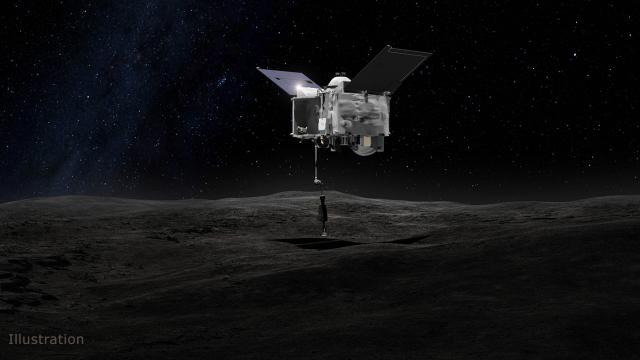NASA’s OSIRIS-REx mission won’t just take pretty pictures of the asteroid Bennu — it will also help scientists learn whether the rock will one day threaten Earth.
There are plenty of reasons to study asteroids. They could be potential mines for precious resources like water and heavy elements, and they contain clues we can study to learn what the Solar System was like in its earliest days.
But also, big things slamming into Earth can have some catastrophic consequences. So scientists are interested in that, too.
Bennu is a 487.68m-wide asteroid that orbits the Sun relatively close to the Earth. OSIRIS-REx, the NASA mission tasked with studying it, launched in September 2016 and arrived at its target this past Monday. The spacecraft carries five instruments: a camera suite, a LIDAR system (like radar, but with a laser instead of radio waves), and three spectrometers, which measure different wavelengths of light to determine the asteroid’s composition.
Bennu is an especially important target when it comes to our own survival. Around every six years, it comes relatively close to the Earth (“close” in cosmic terms, but very far by any other measure). Models suggest that during its close approaches between the years 2175 and 2196, it has a 1 in 2700 chance of colliding with us. That’s still incredibly small (a 99.963 per cent chance of a miss), but Bennu is a big rock — even slim odds are too great to ignore when civilisation is at stake.
Why don’t astronomers know for sure whether we’re safe? There are plenty of forces at stake, and small differences can change the odds. During some of the asteroid’s close approaches, Earth’s gravity will give it a nudge which could shift it onto a collision course.
Furthermore, there’s the Yarkovsky effect, according to a Jet Propulsion Lab press release: the uneven heating from the Sun on such a light body can cause changes in its trajectory. It’s unclear where Bennu will go after 2135.
OSIRIS-REx and telescopes on Earth will continue to characterise the asteroid, tracing its path and determining how gravity and the Yarkovsky effect will influence its trajectory. The mission will hopefully produce trajectories 60 times more accurate than present-day estimates, according to the press release.
So what happens if Bennu becomes a threat? Well, you personally shouldn’t worry, because the odds are very good that you will be dead. Your children, too, will probably be dead.
But researchers are working on a few solutions. One mission called the Double Asteroid Redirection Test will attempt to slam a spacecraft into an asteroid to cause a trajectory change. Maybe we could nuke asteroids.
Or, if we get enough lead time, maybe we can just paint one side to change how it absorbs solar radiation, using the Yarkovsky effect to our advantage.
There’s lots of data to be taken before we know what Bennu will do, and plenty of other interesting science to conduct. But know that Bennu is not the asteroid that you should be worried about. The asteroids you should worry about are the ones that haven’t been detected yet.
[NASA JPL]
